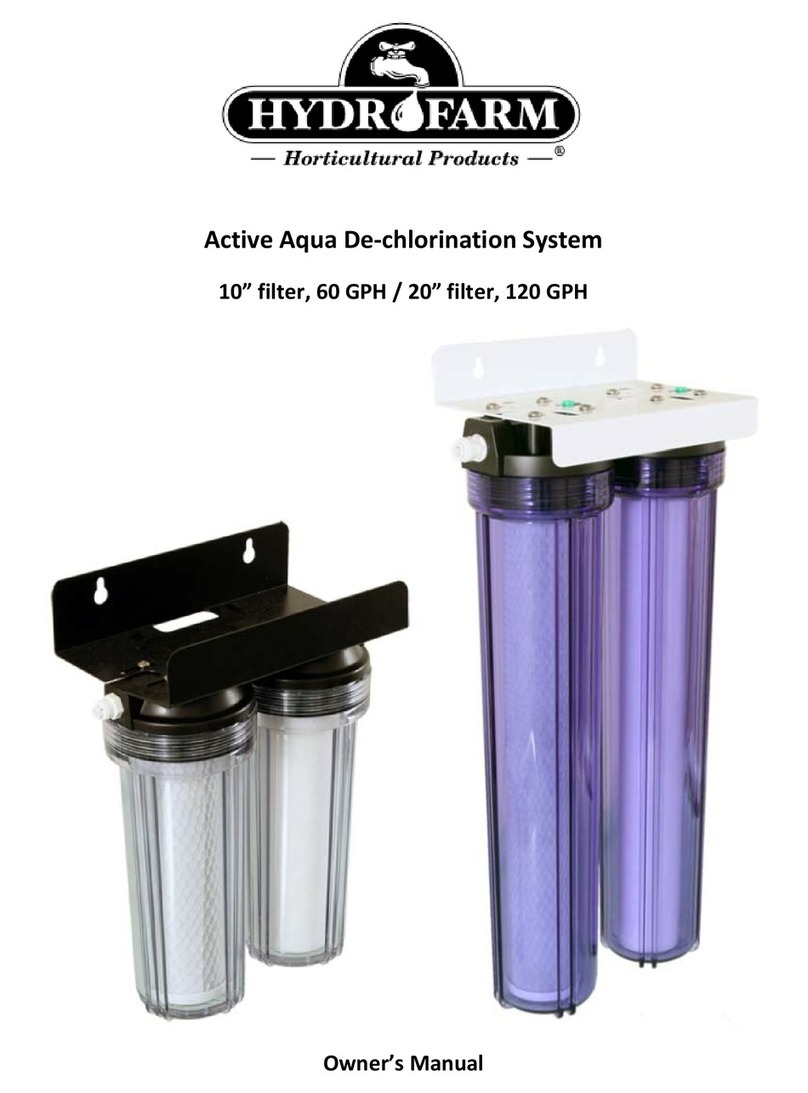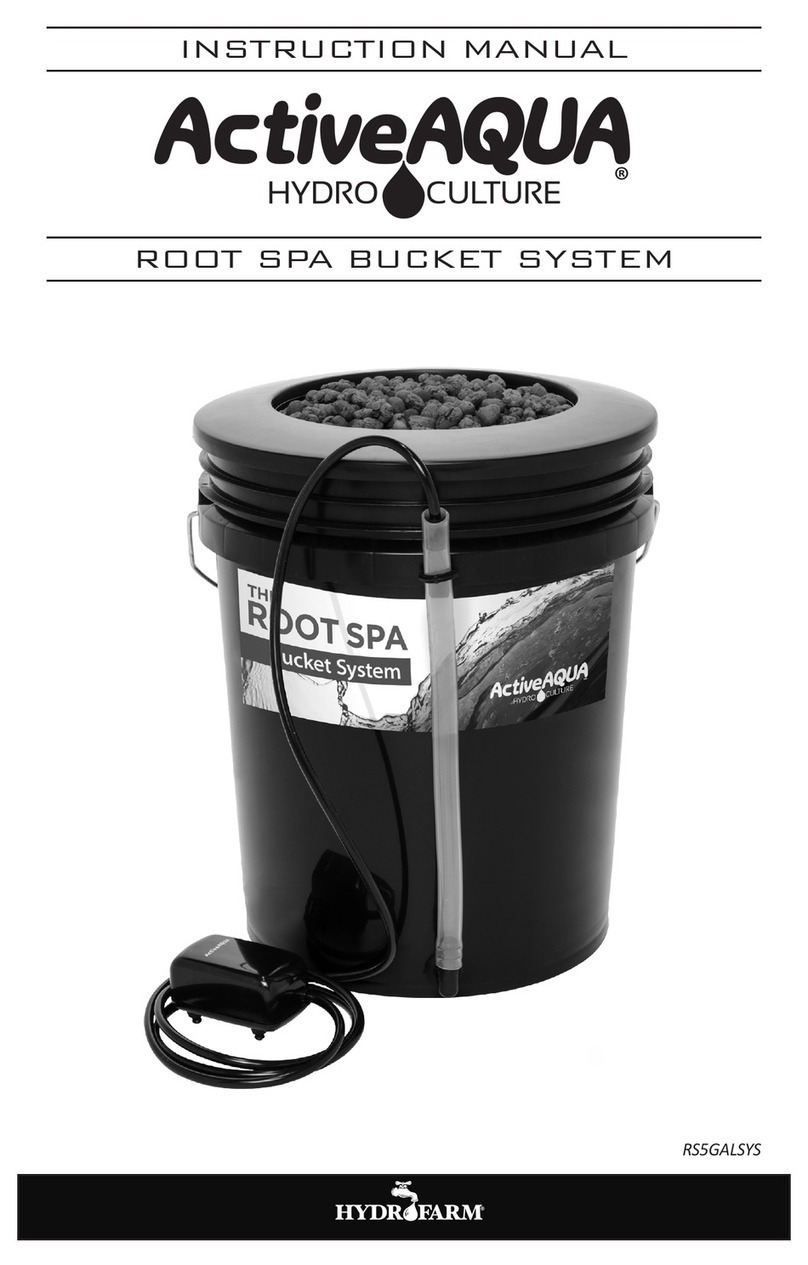www.hydrofarm.com
instructions instructions
Congratulaons on your new Acve Aqua RO water treatment system. Please follow the outlined
steps in regards to the installaon and maintenance of your water treatment system. Proper
maintenance will ensure fresh puried water for many years. If you have any technical dicules or
quesons, please do not hesitate to contact us and we will be happy to assist you.
This 100 GPD R/O unit is ready to hook up to your local water source with the included garden
hose bib adapter. Acve Aqua pressure tests all systems prior to shipping, and your RO membrane
cartridge comes pre-installed in the housing.
Before hooking the unit up to a water supply:
1. Unpack your unit completely.
2. Inspect for any damage or broken parts as a result of shipping.
3. Locate and connect the supply side of the equipment. This is the right side as you face the system.
4. Locate the red drain line, and place in an appropriate area for drainage.
5. Do not install the unit where the source/input pressure exceeds 80 psi.
6. Protect the unit against freezing.
7. Keep out of direct sunlight
8. Do not install where leakage or failure may cause damage to property.
*All Clear Canisters MUST be re-placed aer 3 years. Please contact us if you have problems with
your unit. Customer is responsible for lter and membrane changes and associated costs.
SETUP:
Push in the 1/4” white inlet tubing into the 1/4” ng on the top of the canister labeled “in” (#5).
Connect the 1/4” blue puried water tubing to the open outlet of the membrane (#2). The system
comes with a 3:1 waste water to puried water rao. This is industry standard for most water
sources and gives you the best trade o between membrane life and waste water.
Connect the 1/4” red waste water tubing to the outlet of the ow restrictor (#3). You are now ready
to connect to your system to the water source using the included garden hose adaptor. Make sure all
lines and canisters are secure before turning on the water supply.
1. Source/Inlet Line (White)
2. Puried Water Line (Blue)
3. Waste Water Line (Red)
1. Feed Line From Carbon/
Sediment Combo Filter to
Membrane
2. Puried Water Line (Blue)
3. Waste Water Line (Red)
4. Flow Restrictor
5. Source Water Connecon
(White)
1
2
3
4
5
Turn the source water on unl both the carbon and sediment lters have water in the housings.
Next, open source water up all the way (do not exceed 80 psi). Flush the system for 30 minutes when
the system is new and/or when you replace your membrane.
Filter Replacement Recommendaons:
MEMBRANE ELEMENT – 6 months to 1 year
SEDIMENT/CARBON COMBO FILTER – 2000 gallons (including waste water)
Accessories:
Handheld EC/TDS Meters: A very accurate way to check the performance of your water ltraon
system. Regularly checking the EC/TDS can help detect any problems with early membrane
exhauson. Checking the puried water output for EC/PPM will give you added peace of mind that
your lter is operang properly and your system is receiving the quality of water you need.
RO Water Storage Tanks: These tanks are used by many of our customers to store water or to save
up sucient water to begin a new tank. They can be equipped with automac shuto valves to
reduce waste water.
Membrane Flush Kits: Flush kits are used to extend the membrane life of the lter.
The three major variables that control water ow through the system are temperature, pressure and
incoming water quality!
Filter Change Sheet and Normal Operaon:
Note: This two-stage RO system includes a carbon/sediment combo lter
1. Carbon/Sediment Combo Filter: This combo lter is the rst stage in the RO process. The
sediment poron of the lter eecvely removes parcles and sediments. An example of a parcle
that would be removed is sand. The sediment lter’s life depends on the amount of total parcles in
your water supply. Discoloraon is also a sign that the lter is loaded with contaminants and should
be replaced with a new sediment lter. The carbon poron of the lter eecvely reduces volale
organic compounds in RO water systems. The most cost eecve way to predict carbon lter life
is by measuring the output in gallons. The carbon block will lter 2,000 gal @ 1.0 GPM of 2ppm
Chlorine.
(Do not exclude drain water from this capacity, as it is treated water.)
2. Reverse Osmosis Membrane: This is the rst component in the system that reduces Total
Dissolved Solids (TDS); a common example of dissolved solids can be salts or calcium. A TDS meter is
the best way to determine if your membrane is operang properly. A properly operang membrane
will give you a TDS reducon of at least 90%. Membranes can fail due to Clogging or Scaling, in this
situaon very lile or no puried water will be produced from the RO’s blue line.






















